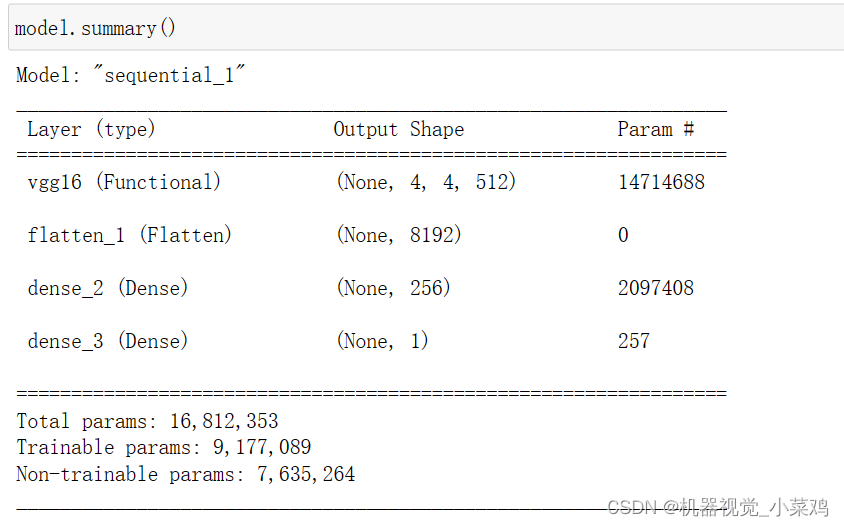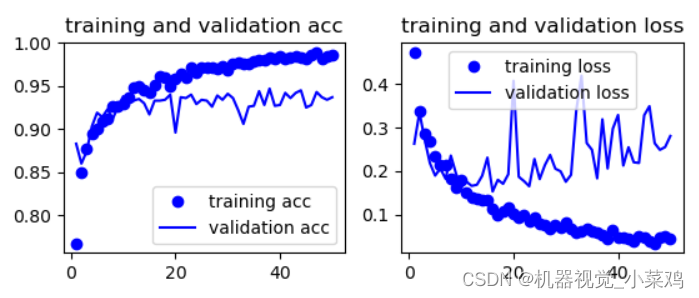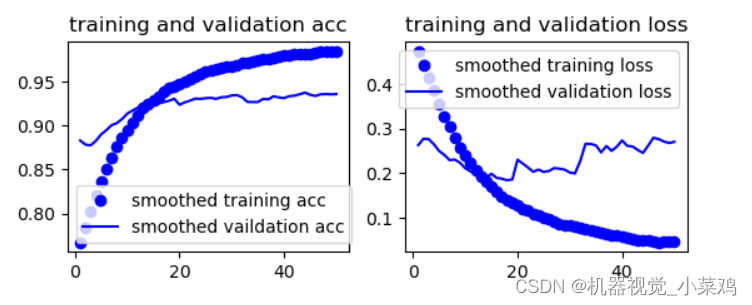微调是指将其顶部的几层’解冻‘,并将这解冻的几层和新增加的部分联合训练。
一、数据准备
from keras.applications import VGG16
from keras import models
from keras import layers
from keras import optimizers
import os,shutil
from keras.preprocessing.image import ImageDataGenerator
base_dir = "/kaggle/input/cats-and-dogs-small"
train_dir = os.path.join(base_dir,'train')
validation_dir = os.path.join(base_dir,'validation')
二、模型加载以及冻结
conv_base = VGG16(weights='imagenet',include_top=False,input_shape=(150,150,3))
conv_base.trainable = True
set_trainable = False
for layer in conv_base.layers:
if layer.name == 'block5_conv1':
set_trainable = True
if set_trainable:
layer.trainable = True
else:
layer.trainable = False
三、添加分类器
model = models.Sequential()
model.add(conv_base)
model.add(layers.Flatten())
model.add(layers.Dense(256,activation='relu'))
model.add(layers.Dense(1,activation='sigmoid'))
查看需要更新的参数

四、生成迭代器
train_datagen = ImageDataGenerator(rescale=1.0/255,rotation_range=40,width_shift_range=0.2,height_shift_range=0.2,shear_range=0.2,zoom_range=0.2,horizontal_flip=True,fill_mode='nearest')
test_datagen = ImageDataGenerator(rescale=1.0/255)
train_generator = train_datagen.flow_from_directory(train_dir,target_size=(150,150),batch_size=20,class_mode='binary')
validation_generator = test_datagen.flow_from_directory(validation_dir,target_size=(150,150),batch_size=20,class_mode='binary')
五、生成优化器,并且开始训练
model.compile(loss='binary_crossentropy',optimizer=optimizers.RMSprop(lr=2e-5),metrics=['acc'])
history=model.fit_generator(train_generator,steps_per_epoch=100,epochs=50,validation_data=validation_generator,validation_steps=50)
六、画出曲线图
import matplotlib.pyplot as plt
acc = history.history['acc']
val_acc = history.history['val_acc']
loss = history.history['loss']
val_loss = history.history['val_loss']
epochs = range(1,len(acc)+1)
plt.subplot(221)
plt.plot(epochs,acc,'bo',label='training acc')
plt.plot(epochs,val_acc,'b',label='validation acc')
plt.title('training and validation acc')
plt.legend()
plt.subplot(222)
plt.plot(epochs,loss,'bo',label='training loss')
plt.plot(epochs,val_loss,'b',label='validation loss')
plt.title('training and validation loss')
plt.legend()
plt.show()

七、平滑曲线
import matplotlib.pyplot as plt
acc = history.history['acc']
val_acc = history.history['val_acc']
loss = history.history['loss']
val_loss = history.history['val_loss']
def smooth_curve(points,factor=0.8):
smooth_points = []
for point in points:
if smooth_points:
previous = smooth_points[-1]
smooth_points.append(previous*factor+point*(1-factor))
else:
smooth_points.append(point)
return smooth_points
plt.subplot(221)
plt.plot(epochs,smooth_curve(acc),'bo',label='smoothed training acc')
plt.plot(epochs,smooth_curve(val_acc),'b',label='smoothed vaildation acc')
plt.title('training and validation acc')
plt.legend()
plt.subplot(222)
plt.plot(epochs,smooth_curve(loss),'bo',label='smoothed training loss')
plt.plot(epochs,smooth_curve(val_loss),'b',label='smoothed validation loss')
plt.title('training and validation loss')
plt.legend()
plt.show()

八、评估模型
test_dir = os.path.join(base_dir,'test')
test_datagen = ImageDataGenerator(rescale=1.0/255)
test_generator = test_datagen.flow_from_directory(test_dir,target_size =(150,150),batch_size=20,class_mode='binary')
test_loss,test_acc = model.evaluate_generator(test_generator,steps=50)
print('test_acc:',test_acc)